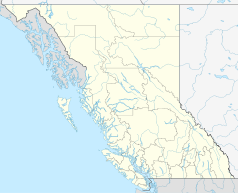Dease Lake, British Columbia
| Dease Lake | ||
|---|---|---|
| Location in British Columbia | ||
|
|
||
| State : |
|
|
| Province : | British Columbia | |
| Regional District : | Stikine region | |
| Coordinates : | 58 ° 26 ′ N , 130 ° 0 ′ W | |
| Area : | 8.56 km² | |
| Residents : | 303 (as of 2011) | |
| Population density : | 35.4 inhabitants / km² | |
| Time zone : | Pacific Time ( UTC − 8 ) | |
| Postal code : | V0C | |
Dease Lake is a small settlement ( Designated Place ) in the northwest of the Canadian province of British Columbia on the lake of the same name, north of the settlement . The settlement is on Highway 37 in the regional district of Stikine Region . Since no municipality is registered in the entire regional district, the settlement forms the population center of the district.
history
In 1834 John McLeod came from Fort Halkett across the Liard River and discovered Dease Lake. In 1838, the fur trader Robert Campbell , an employee of the Hudson's Bay Company , established the Lake House Trading Post on the shores of Dease Lake. The lake was named after the chief factor Peter Warren Dease in 1834 . The trading post played an important role in the local fur trade, but Campbell and his group had to withdraw first. In 1839, the British reached an agreement with Russian traders that opened the region to the Hudson's Bay Company.
However, the Tlingit forced the British to restrict their trade to the coast and even traded with the Tahltan , with whom they maintained intensive contacts. From 1847 to 1849 the Tahltan, the number of which was estimated at 1,000 to 1,500, was hit by a smallpox epidemic , which probably only 300 to 325 of them survived.
In 1861 gold discoveries on the Stikine triggered the Cassiar gold rush. Captain William Moore brought the Wrangell prospectors into the hinterland the next year . Although most of them left in the fall, Governor James Douglas hastily took control of the newly established Stikine region.
In 1873 new gold was found at Thibert Creek, not far from Dease Lake. The gold diggers landed in Glenora and went overland to Dease Lake. Captain Moore was given permission to build a path along the old trade path. The Tahltan suffered from new diseases such as measles , their numbers continued to decline, and eventually they decided to live in one place, no longer clan-wise. The Tlingit's trade monopoly collapsed.
With the Klondike gold rush came thousands of prospectors. In the winter of 1897 to 1898 alone, 3,000 to 3,500 of them camped in Glenora. Telegraph Creek , which linked shipping on the Stikine to the north, was linked to Atlin in 1897 . The Lady of the Lake steamboat operated on Dease Lake.
Demographics
The census in 2011 showed a population of 303 inhabitants for the settlement. The population of the settlement decreased by 21.1% compared to the census of 384 inhabitants in 2006, while the population in the province of British Columbia increased by 7.0% at the same time.
58 people live in the Indian reservation Dease Lake 9 on the lake of the same name north of the village .
traffic
In 1931 the Road Construction Commission proposed the construction of the Pacific Yukon Highway , which would connect Washington and Alaska , and for which an asphalt surface was planned in 1939. The main artery today is Highway 37, which also put an end to shipping traffic on the Stikine in 1972.
From 1969 the construction of a railway line from Odell or Fort St. James by the Pacific Great Eastern Railway (later British Columbia Railway ) began. In 1976, due to the high costs, the construction of the almost completed line was abandoned.
The only airline that flies to Dease Lake Airport, southwest of town , is Northern Thunderbird Air . It connects the place with Smithers .
See also
Web links
Remarks
- ↑ A photo from this period can be found in the British Columbia Archives : Steamer 'Lady of the Lake' on Dease Lake near Cassiar; looking south from Porter's Landing. ( Memento from September 23, 2015 in the Internet Archive )
- ^ Dease Lake Community Profile. Census 2011. Statistics Canada , November 2, 2012, accessed November 25, 2012 .
- ^ Dease Lake 9 Indian Reserve. Census 2011. Statistics Canada , November 2, 2012, accessed November 25, 2012 .
